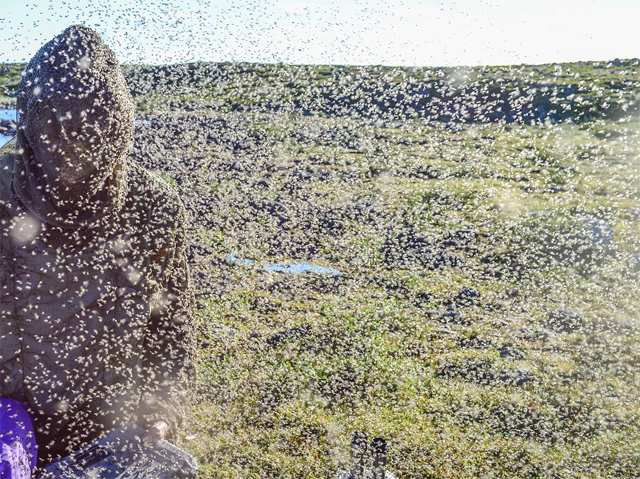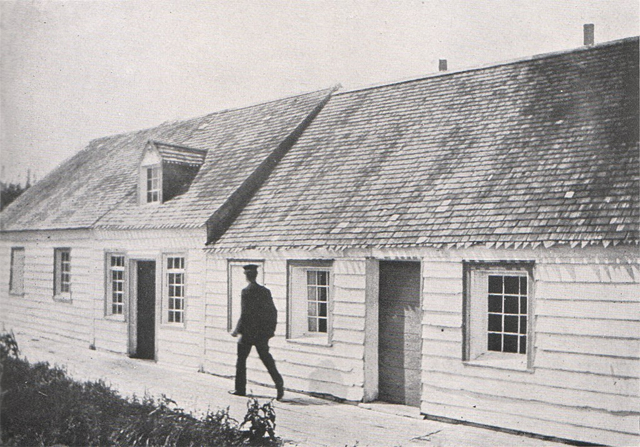The sea around the coast of Labrador is warming rapidly and the loss of winter ice threatens the culture and way of life of the Inuit in Rigolet. According to a report in The Guardian last week, Rigolet, located on the north shore of the Hamilton Inlet, is the southernmost Inuit village in Canada.

The immediate concern among the residents of Rigolet is that many of them still derive a fair amount of their food from the land and the sea. They harvest and store berries picked in season as well as fish and game, and they are allowed to hunt two polar bears per year. Their skills in getting those traditional foods are becoming irrelevant as travel, particularly in winter, becomes increasingly difficult. They store their foods in community freezers to share with the elderly and others who cannot get out to hunt and gather for themselves. But when they are cut off from their traditional hunting, gathering, and fishing areas, the Inuit have to rely on expensive processed foods.
Robert Way, a climate scientist based in Labrador, said that extreme variations in weather patterns are having the effect of masking long-term, serious climate changes that are occurring. Winter is now six weeks shorter, he said, and the extent of the sea ice during the winter months is roughly one-third less than what it was even 10 years ago. “If you look at the rate of warming from the late 1980s to 2015, this is one of the fastest warming places in the world. It’s quite concerning,” he said.

Since there is no through road along this section of the coast of Labrador, the Inuit of Rigolet have to rely on travel over the water—and over the ice in winter—for access to the outside world. But when, for months at a time, ice conditions are fragile or virtually nonexistent, they are cut off from supplies and food.
Derrick Pottle, an Inuit hunter and trapper in Rigolet, told The Guardian that his ancestors have no memory or tradition of winter changes such as they are seeing now, with shrinking or absent ice. “You can’t travel safely any more. Up and down the coast, it’s the same thing. And it’s changing right before our eyes,” he said.

The tormenting clouds of black flies that the Arctic lands are famous for also appear to be getting worse. An employee of the government of Nunatsiavut, Paula McLean Sheppard, said that she confronted a massive cloud of the insects last summer that was so thick she had to turn on her windshield wipers in order to see out. She said the black fly plague used to start by the end of June but now they are out in force in May. She told the reporter that this most recent winter, the bay was not covered with ice until February, months later than normal. The people of Rigolet feel trapped, she said, because they can’t get out to hunt and gather their food. They have a definite need for strong, solid ice to connect them with others.
The impact of these changes is much worse than just cosmetic concerns that could easily be met, according to Ashlee Cunsolo, Director of the Labrador Institute in Happy Valley-Goose Bay. The land is essential to the Inuit and getting out on it is a vital part of their makeup. She said that being unable to get out as their ancestors have done is culturally devastating for them. Social workers and researchers such as Cunsolo believe it is fostering feelings of anxiety, grief, and depression and leading to destructive tendencies such as alcoholism, drug abuse, and suicides.

According to Jack Shiwak, the mayor of Rigolet, the unpredictable nature of the weather is causing people to delay and cancel their regular trips to their cabins in the remote forests. They used to visit them regularly to trap fur animals, another one of their traditions dating back to the commercial fur-trading era. But despite the fact that they used to visit their cabin almost weekly, Shiwak said they’ve not been able to go in the past two years. Inez Shiwak, his daughter, said that getting out of the village onto the land is comparable to a baby taking her first breath of air.
Martin Shiwak, out on the precarious ice with his eight-year old son Dane on their snowmobile, told the reporter as he unzipped his coat that this has been the mildest March in memory. He said he is starting to lose touch with the land, however. This is the first winter that he has not been able to cross a frozen Lake Melville, part of the Hamilton Inlet estuary, to go trapping. It was also the first winter that he was unable to schedule an educational program for the young Inuit, when he would take them out on the ice and show them their traditional winter practices.
Although the reporter got to witness Dane shooting a couple partridges from their snowmobile, Martin worried about the conditions that the boy will face when he grows up. He will have to learn new ways of living with the land.